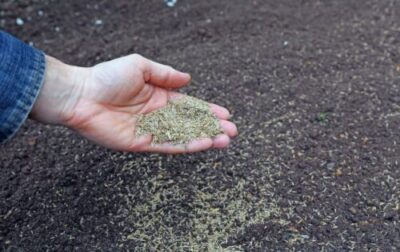When it comes to planting grass seed, too much rain is one of the factors that can affect your success. Once you learn how to properly water your grass seed, you’ll have a lush, green lawn that looks as good as a professionally maintained yard.
Disclosure: This article may contain affiliate links – that means we may receive a commission if you make a purchase after clicking on these links. This is at no extra cost to you.
Too much rain for your grass seed can wash out the soil and water your seed down which will make it difficult for the seed to grow. When you plant grass seed, it needs around one inch of rain or less per week for proper growth. To avoid overwatering, make sure your soil has good drainage.
It’s important to follow your local weather report, choose the proper area for planting grass seed, and plant the seed at the right time of year.
Read on to learn how to incorporate all of these factors to ensure that your grass seed takes root and begins growing.
Can Grass Seed Have Too Much Rain Water?
Here are some signs that indicate your grass seed has too much rainwater:
- Root damage
- Shallow growing roots
- Loss of nutrients in the soil
- Washed away fertilizer
- Fungal or bacterial growth
- Drowned roots
- Pest issues
- Weeds
These issues all stem from the same problem. Too much rainwater is saturating the ground, making it difficult for grass seed to root and grow properly. In addition to washing away the nutrients, the wetness invites all sorts of hosts into your lawn.
This compromises the seed’s ability to protect itself when it’s constantly wet.
What Does an Overwatered Lawn Look Like?
You’ll know that your grass has too much water when you notice that the soil is pooling water and the seed is starting to wash away.
You’ll likely see certain areas of your lawn with puddles and others that are remaining drier.
This is often due to an uneven lawn that has hills, valleys, and slopes.
Even small unevenness in your lawn can have major effects on the way that your lawn holds water as well as where it runs off.
How Do I Stop My Grass Seed From Washing Off?
The best way to avoid washing away your grass seed is by following these simple tips:
- Plant your new seed in a spot with good drainage.
- Plant your grass seed at the right time of year.
- Water it for about one inch per week or less.
- Use a smaller hose
- Plant a cover crop
Make sure to keep an eye on your new grass seed regularly so you get familiar with its look. If you can’t identify the seed in your lawn, it will be hard to tell whether or not it has been washed away.
You’ll also want to learn how to identify signs of mold in your soil. This will look
- Light green
- White
- Black
It will be a coating on top of your soil.
If you notice mold in your grass seed soil, you can remove it from your soil by scrubbing it out with a plastic brush and water.
Scrape it off with the edge of a shovel, then firmly scrub where you see any signs of mold.
For larger areas of soil, use a pressure sprayer to saturate the affected area and scrub it clean.
The best time of year to plant grass seed is in late fall or early winter. This will put the seed in a position to take root before the next growing season, and it will also have plenty of time for growth underneath your ground blanket.
Can I Put Grass Seed Down While It’s Raining?
The best time to sow grass seed is before it rains. It’s easier and more effective to work dry soil when you’re raking the seeds in. Mulching your seedbed with straw or hay can help keep the soil moist, which is helpful for germination and early growth.
When water turns into a sludgy mess and raindrops seep deep in already soggy ground, many people might think this is a good time for planting some seeds – but they would actually do more harm than good.
The problem with planting grass seed after rainfall is that our feet will compact the soil easily. Doing so could lower levels of oxygen and aeration that are necessary for the seed’s healthy growth.
If you can’t avoid planting during a rainy day, make sure to cover your seed with a thin layer of mulch or soil.
This will help it retain the necessary moisture and nutrients that are crucial for taking root in an already wet environment.
Summary
We’ve provided some helpful tips and advice for successfully planting grass seed, but it is up to you to decide when the best time is.
If rainstorms are in your future, make sure you plan accordingly so that you can get everything done before too much water drowns out all of those new roots!
Be careful how often you water your grass seed. Remember that experimentation with some knowledge can lead to a successful lawn.


